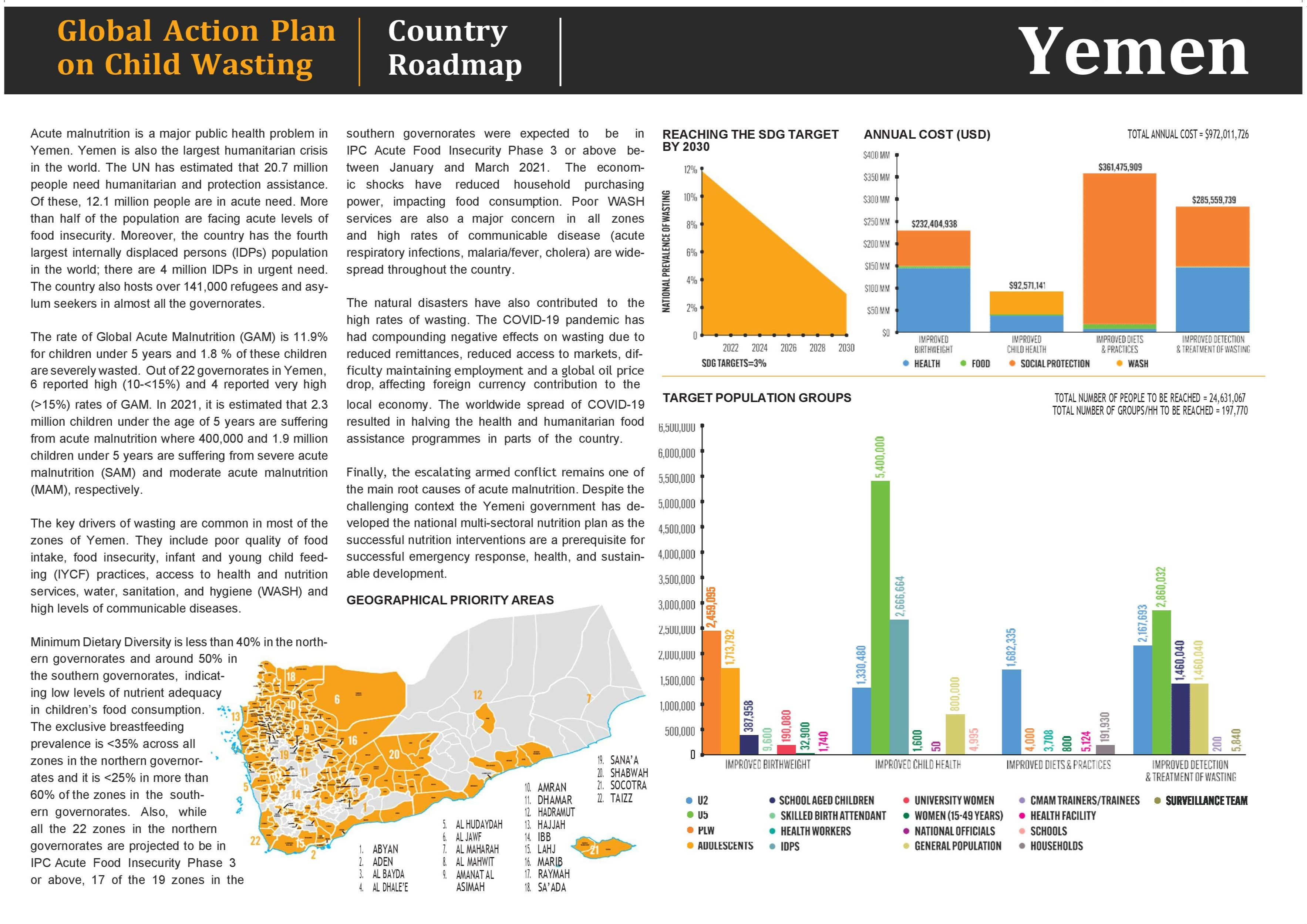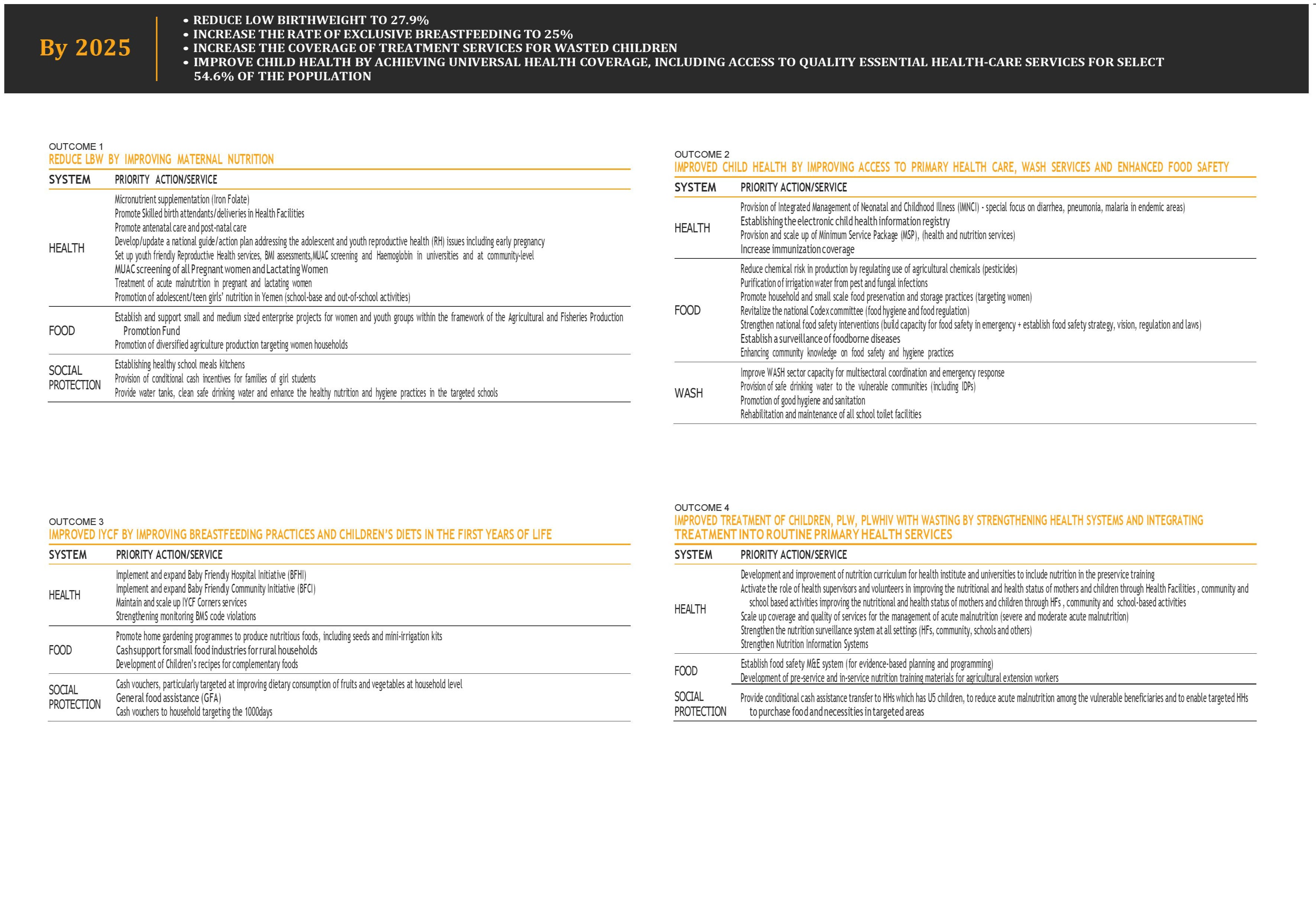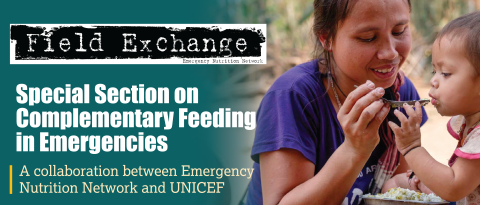Developing the Yemen Action Plan on child wasting: A success story
Karima Al-Hada’a is a Planning and Liaison Specialist at the Scaling-Up Nutrition Secretariat at the Ministry of Planning and International Cooperation, Yemen.
Najwa Al-Dheeb is a Nutrition Specialist at UNICEF, Yemen.
Koki Kyalo is a Nutrition Specialist at UNICEF, Yemen.
Najwa Rizkallah is Nutrition Chief at UNIICEF, Yemen.
The authors would like to thank the combined efforts and ongoing contributions of Scaling-Up Nutrition, the Food and Agriculture Organization, the World Health Organization, the World Food Programme, UNICEF and the Government of Yemen.
|
Key messages :
|
Background
Since 2014, Yemen has been embroiled in a civil war which is considered to be one of the largest humanitarian crises in recent history. The conflict has led to widespread food insecurity, rampant disease, economic collapse and the breakdown of public services. Severe food shortages, soaring food prices and disrupted livelihoods have made basic necessities unaffordable to many. This has exacerbated the high levels of acute malnutrition (wasting) already seen over the past three decades in Yemen.
Results from the latest SMART survey showed a national wasting prevalence of 9.9% among children 6-59 months of age, with some zones, i.e., Hajjah and Hodeidah, exceeding 15% (OCHA, 2022a; 2022b). The latest Integrated Phase Classification exercise showed that the acute food insecurity and malnutrition situation has further deteriorated in 2022, with 538,000 children under five years of age suffering from severe wasting. Furthermore, 1.3 million pregnant and lactating women are projected to suffer in 2022 from acute malnutrition (IPC, 2022). Childhood stunting rates are also very high (44.8%). The country has the fourth largest number of internally displaced persons (IDPs) in the world with four million IDPs in urgent need of humanitarian assistance (OCHA, 2021).
Given this persistent fragile situation, nutrition stakeholders identified the need for a more purposeful, systematic, integrated, transparent and accountable collaboration that leverages the strengths of each stakeholder to collectively act on an overarching goal – to reduce malnutrition across the country. Thus, Yemen seized the opportunity to be a ‘front runner country’ for the adaptation of the UN Global Action Plan (GAP) framework (2022) at the national level, developing the Yemen Action Plan (YAP) on child wasting as a coherent and coordinated multi-sector response to prevent and treat malnutrition.
This article describes the experience of developing the YAP on child wasting and setting up a four-year roadmap of action.
Developing the wasting action plan
Setting up a YAP taskforce
Yemen joined the Scaling Up Nutrition (SUN) movement in 2012 and committed to adopting a multi-sector approach to delivering nutrition services and addressing the direct and underlying causes of malnutrition. Based within Yemen’s Ministry of Planning and International Cooperation, the SUN Secretariat was established as the focal point for the SUN movement.
With technical and financial support from UNICEF, the YAP process was initiated by the SUN Secretariat in Yemen to ensure the convergence of humanitarian actions and inspire development efforts upheld by sectors in the country. The YAP was developed through a consultative process including various technical teams from the ministries responsible for health, agriculture, fisheries, food safety, education, water, sanitation and hygiene (WASH) and social protection and the four United Nations (UN) agencies that have a mandate related to nutrition – the Food and Agriculture Organization (FAO), the World Food Programme (WFP), the World Health Organization (WHO) and the High Commission for Refugees (UNHCR). Despite the political unrest associated with the splitting of the government into two factions in 2014, the SUN Secretariat managed to technically work with and represent the line-ministries of both governments.
In October 2020, SUN Yemen and UNICEF formed a Taskforce Team of UN agencies to provide technical support in identifying priority areas/interventions for all systems in the fight against malnutrition and to provide oversight when developing the YAP. UNICEF headquarters also provided technical support. While a draft workplan was agreed upon during initial Taskforce meetings, this continued to evolve according to wider consultations with agencies and technical ministries from the two sets of governments.
"The process of preparing the YAP itself was a mechanism for building the capabilities of technicians in all sectors, which contributed to bridging the competency gap and enhanced on-the-job training; it also enriched the common ground for the nutrition multi-stakeholders’ platform" Dr. Ali Al-Walidi, Deputy Minister of Primary Health Care – MOPHP
Logistics and technical contributions
At the start of the YAP’s development, the Secretariat and UNICEF identified the financial and technical needs. Technical needs included approximately 15 experts from UN agencies, namely UNICEF, the Nutrition Cluster, WHO, FAO, WFP and UNHCR. At least 30 national experts from multiple sectors also participated, along with a national and an international consultant.
The technical team contributions from the government and other stakeholders involved participation in multilateral meetings and supplementing the plan with interventions, the reviewing of the included activities and providing inputs into the plan at all stages of its development.
Reaching a shared vision
A prerequisite to working towards a joint roadmap was reaching a consensus on Taskforce objectives. Because each system involved (health, food, WASH and social protection) had divergent strategies, the Taskforce reviewed priority actions from each one. Based on criteria such as relevance, ownership, consistency, inclusiveness and how up to date the actions were, the Taskforce agreed on the action plans used to map the YAP’s policies and activities.
Trust, mutual understanding and respect between Taskforce members was instrumental to building consensus around this shared vision.
Mapping and prioritising YAP activities
The Taskforce conducted a mapping of the key nutrition-specific and nutrition-sensitive interventions implemented in the country. Following orientation from SUN Yemen, the government’s technical teams then populated the templates that were provided to countries to adapt the GAP framework.
Following this, about 100 interventions were documented and mapped, mainly extracted from the Multi-Sectoral Nutrition Action Plan, the national nutrition strategy of the health sector and the national maternal and child health strategies. The YAP taskforce reviewed and prioritised interventions, focusing on those considered the most impactful, i.e., taking a ‘less is more’ approach to prioritise ‘less’ activities with ‘more’ focus to increase the likelihood of funding. The reduced list of interventions was discussed with the line-ministries of each government and UN agencies on various occasions, such as main plenary sessions and/or in multilateral meetings. Several multilateral and multi-sector consultations and workshops were held to complete prioritisation, resulting in a YAP operational roadmap.
This was a lengthy process due to the need to reach consensus among all stakeholders in a country context where two sets of ministries sometimes had competing priorities.
Development of sub-activities and targets and costing of YAP activities
Once consensus on the YAP operational roadmap was reached, SUN Yemen held two workshops in Sana’a and Aden to support the technical teams from the ministries of each government to review the roadmap and to facilitate the drafting of sub-activities.
While drafting their sub-activities, the ministries had the opportunity to align their activities with available and related policies and map responsibilities against activities (accountability framework) in the YAP. At this stage, various ministries also began to estimate the number of people who would benefit from each intervention (targets) and the cost of each activity.
A local consultant supported the development process and consolidated the targets and budget for each activity. In September 2021, the final draft of the YAP operational roadmap, which contained the list of activities and a clear accountability framework, target populations and budget, was finalised. By the end of October 2021, after a last round of consultations with the technical team from the government, the YAP was validated by the government and shared with UNICEF headquarters. UNICEF headquarters then facilitated a review by an international team comprised of representatives from UN agencies that support countries in developing their country-level GAPs.
"Yemen’s Action Plan on wasting represents an important step towards mobilising more resources to support the implementation of the national priorities in all sectors that have the highest impact on the nutrition situation in Yemen.” said Abdulkarim Nasser - Head of SUN-Yemen Secretariat
The Yemen country roadmap
In collaboration with the SUN Secretariat and UNICEF Yemen, UNICEF headquarters prepared the YAP summary sheet (Figure 1). This ‘country roadmap’ comprised the geographic areas to prioritise, the targets to achieve (in terms of wasting levels), the annual costs estimated and the number of beneficiaries to target per population group.
The country roadmap also quantified specific outcome targets for Yemen. By 2025, Yemen aims to:
- Reduce low birthweight from 23% to 16%
- Increase the rate of exclusive breastfeeding from 20% to 30%
- Increase the coverage of treatment services for wasted children to 54%
- Improve child health by reaching 54.6% National Universal Health Coverage Index, up from 42%
Under each outcome, specific priority actions and/or services were identified among the four systems identified as contributors to wasting reduction, i.e., health, food, social protection and WASH.
The YAP informed the development of the global commitments at the Tokyo Nutrition for Growth summit and was presented at the summit in December 2021. The YAP is considered a success story, given the timeline for its development and the ability of the process to reach consensus by the two governments on a single action plan.
It was agreed that country stakeholders would establish themselves as an ‘Operationalisation Team’ for the YAP to ensure effective coordination and funding mechanisms for implementation and to develop a monitoring framework to track the progress of this nationwide roadmap. The YAP Operationalisation Team comprises a group of around 15 members from the government, UN agencies, international and national non-government organisations and donors committed to supporting the effective implementation of the YAP. In the coming year, they will act as focal points to link the YAP operational group to the decision-makers and the technical teams in their organisations. They will bring the required expertise to support the development of the YAP’s operational plan and implement the required activities within their own organisations to achieve the YAP’s relevant tasks. They will also support national and international experts, provide technical support and ensure the development of appropriate reporting.
Figure 1: Yemen Action Plan summary sheet


Successes, challenges and lessons learned
Despite competing priorities and an overwhelming workload in a dynamic and humanitarian context such as Yemen, the national team tackled the intense process of developing a country-wide roadmap for child wasting smoothly, with much attention and dedication. The resulting YAP is a four-year roadmap that was costed to mobilise USD four billion to combat child wasting.
The development of the YAP resulted from a transparent and collaborative effort. All the partners involved, from the line-ministries of both governments to the five UN agencies, demonstrated high levels of accountability and responsibility towards the people suffering due to the situation in Yemen. The process demonstrated the need to harmonise and integrate efforts to address the core causes of wasting and to mobilise more support for the overlooked crisis in the country.
Collaborative efforts resulted in a success story because different experiences from different fields of expertise were shared, enabling a consensus on the framework and the entire roadmap. Moreover, clear roles and tasks, objectives and expectations created harmony between different stakeholders; not only “mutual interests” but also “mutual understanding”.
The SUN Secretariat in Yemen acted as the link between both governments in the country. The Secretariat was able to maintain coordination through bilateral meetings with both governments to reach a consensus on the sectoral actions. This was successfully obtained thanks to appropriate transparency and two-way communication involving all stakeholders. Consensus was instrumental to ensuring buy-in by both governments towards the implementation of YAP activities and allowing access by partners to the geographic areas under both governments’ control.
Since the priority actions identified in the final country roadmap were derived from existing national strategies and policies, the action plan for wasting was contextualised for Yemen and built upon established and distinct roles and responsibilities in the country which could be used as a reference platform for multi-sector programming. YAP finalisation was leveraged by the decision makers’ acknowledgement of the importance of the action plan.
Going forward, the objective is to support and advocate for the operationalisation of the YAP. The YAP is considered one of the most important mobilisation tools among Yemen’s national plans as it has prioritised the most impactful intersectoral interventions and has the potential to impact on outcomes directly linked to child wasting.
"YAP is just a first step, and the challenge is to push all partners to implement these interventions on the ground so that they become tangible for the actual beneficiaries." Dr. Nazar Basuhaib – Vice-Minister of Planning and International Cooperation
Conclusion
Despite a very challenging context, the YAP on child wasting and the corresponding country roadmap were developed. They have the potential to ensure prioritisation of effective nutrition interventions that are a prerequisite for successful emergency responses, improved health outcomes and sustainable development.
The YAP development process was successful in bringing stakeholders together to reach consensus and leveraged the technical capacity within the country for greater ownership. Furthermore, the YAP was built on existing policies and guidelines to maximise the use of available resources and ensure higher accountability of each stakeholder.
Although the YAP has been uploaded online, there is more to be done to achieve its ultimate goal for wasting reduction. The YAP Operationalisation Team members will work together in a trusting, collaborative and transparent manner to achieve the YAP’s objectives. The team will aim to provide a robust and creative pathway to finance and implement the YAP, deliver concrete proposals towards achieving outcomes for nutrition and facilitate key partnerships and advocacy efforts for ramping up nutrition finance, including the engagement of partners on internal and external resource mobilisation. Sustainability, transformative approaches and long-term capacity development will be considered in all deliberations.
For more information, please contact Karima Al-Hada'a at karima.mopic@gmail.com
References
Global Action Plan for Child Wasting (2022) Country Roadmaps - Yemen. https://www.childwasting.org/the-gap-framework
IPC (2022) Yemen: Acute Malnutrition Situation January - May 2022 and Projection for June - December 2022. https://www.ipcinfo.org/ipc-country-analysis/details-map/en/c/1155480/?iso3=YEM
OCHA (2021) Humanitarian Needs Overview 2021 – Yemen. https://reliefweb.int/sites/reliefweb.int/files/resources/Yemen_HNO_2021_Final.pdf
OCHA (2022a) Humanitarian Needs Overview 2022 – Yemen. https://reliefweb.int/report/yemen/yemen-humanitarian-needs-overview-2022-april-2022
OCHA (2022b) Humanitarian Response Plan 2022 – Yemen. https://reliefweb.int/report/yemen/yemen-humanitarian-response-plan-2022-april-2022


